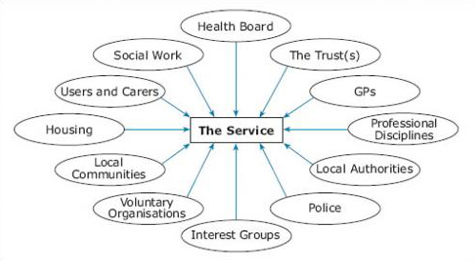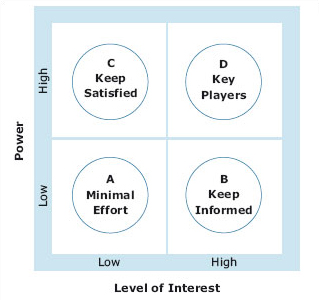4.2 Stakeholder analysis
Figure 3 illustrates the range of stakeholders who could have an interest in health-related community social marketing programmes.

A major concern of decision makers is the need to balance the often conflicting expectations and interests of stakeholders. Stakeholder analysis asks:
Who are the stakeholders in a particular issue or activity?
What are the expectations and objectives of the various stakeholder groups?
What are their interests and how interested are they?
How dependent is the organisation on each group and how is this changing over time in terms of :
the degree of power (potential for disruption) that the group exercises?
possibility of replacing the relationship?
extent of uncertainty in the relationship?
Mendelow's matrix (see Figure 4) describes four types of stakeholder. It should be noted that the classifications are context specific and dynamic, for example, stakeholders in Group C may move in to Group D if their interest in a particular project increases. Additionally, those in Group B may become empowered by access to key players, media attention, etc.

Activity 5
Read the case study entitled ‘The challenges of using social marketing in India: The case of HIV/AIDS prevention’, linked below. If you were developing this social marketing campaign, which stakeholder groups would you have to take into consideration? Use Mendelow's matrix to classify the groups according to their interest and power.
Click the link below to open the case study. (5 pages, 115KB)
Case Study 11 [Tip: hold Ctrl and click a link to open it in a new tab. (Hide tip)]
Discussion
There are many stakeholder groups involved. You may have made a number of assumptions in your analysis so make sure that these have been clearly stated.
Central government – D. They have control over resources and ultimate responsibility for success. There may be lack of interest in some parts of government, or influences due to corruption, etc. …
Non-governmental organisations (NGOs) – B. Low in resources but interested in the success of the programme. We do not, however, know about other sources of power such as the ability to influence or exert political pressure.
Department for International Development – as NGOs above.
Retailers/potential retailers of condoms – C. High power as they can control the supply of condoms but because of the various cultural influences they have little interest in the issue. However, as the programme proceeds they may become key players.
Consumer groups – A. The various consumer groups discussed in the case appear to have little power in influencing the nature of the programme and little interest. However, as the key target market, the social marketer would aim to shift this stakeholder group by changing perceptions to move them to the B quadrant.
